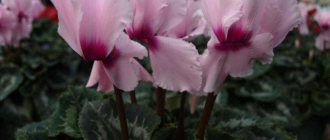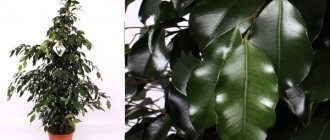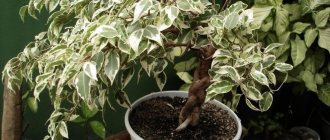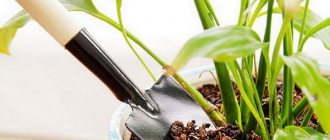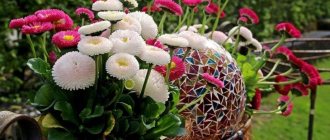Large, bright, beautiful Persian cyclamen, which are actively sold in pots in all flower shops in winter, of course, will not grow in our garden. But you can plant the relatively winter-hardy cyclamen Kos.
- Kossky cyclamen (Cyclamen coum) Features of planting cyclamen
- Problems with growing cyclamens in the garden
- Purple cyclamen (Cyclamen europaeum, Cyclamen purpurascens)
Features of caring for Kos cyclamen
Watering, fertilizing, pruning and replanting a plant into a new substrate play an important role in its cultivation.
Proper care always ensures the harmonious development of any flower, which is why it is so important to know about all the possible nuances
How to water a flower
Kos cyclamen, like many of its hybrids, requires regular but dosed watering, especially during the growing season
Liquid application is usually done by immersion, and when watering from above it is important to control this process so that water does not get on the leaves and tubers
It would be more correct to pour the liquid over the edge of the pot. During the dormant period, the plants reduce the amount of moisture, but do not allow the soil to dry out.
Top dressing
During the process of active flowering and growth of the plant, it must be fed once every 2 weeks, using complex mineral fertilizer (usually the required dosage is indicated on the package). After sowing the plant (when grown from seeds), in the first 6 months, organic matter must be added along with mineral compounds.
Plant pruning
Pruning is practically not required for cyclamen Kos, but for its normal growth and development it is necessary to promptly remove faded flowers and wilted leaves, and the bases of the pedicels, which are prone to rotting, also need to be removed.
Correct transplant
Replanting cyclamen (not only Kos) should be done regularly: every year at the same time, before budding begins. Usually this time occurs in the middle of summer, when new leaves gradually begin to grow.
Do not underestimate the importance of this procedure, since within 12 months the soil in the pot is greatly depleted, which also deteriorates its structure. When replanting, you are required to completely replace the old soil mixture with a new one, with the obligatory removal of rotten and dead roots
Important! If your plant is no more than 1.5 years old, then a pot with a diameter of about 8 cm is ideal for it, while for a three-year-old plant 15 cm is ideal.
If you want your cyclamen to live for a long time and delight you with its color, it is important to prepare the right soil mixture, which is most often created from leaf soil, humus, sand and peat. You will need a little more leaf soil than the other ingredients, which are taken in equal proportions.
If you do not want to prepare the substrate yourself, then it can be purchased ready-made at any specialized store
You will need a little more leaf soil than the other ingredients, which are taken in equal proportions. If you do not want to prepare the substrate yourself, then it can be purchased ready-made at any specialized store.
Having dealt with the new soil and selected the appropriate container for the further development of your cyclamen, make small holes at the bottom of the pot and lay drainage in the form of ordinary pebbles or expanded clay, which will protect the plant from waterlogging.
When pouring new soil into a pot, there is no need to compact it, and to improve the health of the cyclamen, simply remove (unscrew) a few old leaves before placing it in a new container. The replanting procedure itself requires carefully removing the plant from the old pot and equally carefully transferring it to the new one.
The flower should be placed exactly in the center, and it should be kept suspended for some time so that the roots are not damaged. They are carefully straightened out and only after that they begin to add the rest of the soil (at first only the bottom is filled with the substrate).
To protect the plant from damage to the roots, they, along with the bulb, are taken out of the old pot, preserving the earthen lump.
Important! There is no need to cover the entire tuber with soil; it should stick out a little.
How to grow from seeds?
How to grow dry wood from seeds? It's not as difficult as it might seem. However, this is not the only way; there are three ways to propagate a flower:
- seeds;
- dividing the tuber;
- daughter processes.
But we will figure out how to grow dry wood yourself from seeds. You can see step-by-step instructions in the photo after the description of the actions with the flower. Growing from seeds will require a lot of your time, as this is quite a complicated matter.
There are several stages of growing cyclamen by seeds.
Preparatory stage. This stage consists of soaking the seeds in a solution of potassium acid manganese, or you can purchase stimulants at a flower shop. Such drugs as “Etamon”, “Zircon”, “Epin-extra” are popular. The stimulant must be diluted according to the instructions that come with the drug. Prepared solutions of stimulants should be moistened with a cotton pad or gauze, which should be folded in several layers. Do not forget to monitor the moisture content of the fabric; you must not allow the grains to dry out during the twelve-hour soaking.
Planting seeds. Planting prepared grains is simple. The grains that have been processed are placed in previously prepared soil, maintaining a distance between the seeds, which should be two to three centimeters. The soil consists of leaves and peat, taken in equal quantities, you can use coconut tablets, they are also great. A mixture of sand and peat is sprinkled on top of the seedlings, and the layer thickness should not be more than one centimeter, otherwise it will be difficult for the sprout to germinate. Water the seedlings generously. Please note that the seeds are planted in an opaque container, which is used as a mini-greenhouse, and the soil should be laid in it in a layer not exceeding 6-7 centimeters. Maintain the humidity level and cover the container with a matte lid. The ideal temperature for development is +18ºС. If the temperature is higher than specified, it is detrimental to the seeds. It is also worth keeping the seedlings in a dark room.
Note! Germination takes quite a long time - about 40 days.
First, the seeds will develop roots and small tubers, then they will take root in the soil. After this, the tubers will unfold purple-pink loops.
During the germination period, minor difficulties arise. It takes a long time for the first leaf to cut through the skin of the seed and fail to unfurl. With sufficient air humidity, the plant independently solves this problem, gradually throwing off the scales of the seed from the sprout. Sometimes the sprouts remain in the scale for a very long period. Don't worry, the next leaves from the tuber in the soil will sprout and shed the seed skin. Help the flower in the form of moistened cotton wool, carefully placed on it for an hour and a half.
As soon as the first sprouts appear, the seedlings should be moved to a bright room, but not under direct sunlight. Maintain a temperature regime not exceeding +18ºС and moisten the soil daily.
Picking seedlings. At the moment when two leaves of the plant are fully formed, picking the seedlings begins. By this time, a tuber has formed and the flowers are planted in containers for young growth, sprinkling the roots of the plant with a mixture of leaf soil, turf soil and sand. Up to 3 plants are placed in one pot, and in a box - according to the “6:6” scheme. You need to replant carefully, with a small amount of soil around the tuber. After the work done, the growth of the flower accelerates. Rooting of the plant occurs within three weeks. With proper care, temperature, lighting and soil moisture, your cyclamen is not at risk of any kind of deformation.
Transplantation to the place of growth. To transplant to a permanent place of growth, you need to cover the bottom of the pot with a two-centimeter layer of drainage (you can use foam, brick, pebble or expanded clay). Then the drainage is covered with earth. You should not use a pot of large diameter, since replanting will be done several times as it grows.
So, let’s summarize what you will need to grow cyclamen, or dryweed, from seeds:
- high-quality seeds purchased from flower growers or in a store;
- drugs that stimulate plant growth - “Epin”, “Zircon”, “Etamon”;
- ready-made earthen substrates, peat, sand and leaf soil;
- drainage;
- cover or opaque film;
- fertilizers rich in minerals;
- pot for sowing seeds and transplanting seedlings.
Follow all the above rules for caring for seeds and seedlings, you will get the desired result, which will undoubtedly please you.
How to plant?
Decorative cyclamen can be purchased at any flower shop. In this case, the plant can be left in store soil for some period. In the future, it needs to be completely changed or brought to the proper form gradually. To achieve the second, it is necessary to regularly, but not in large quantities, feed the flower with various fertilizers of natural origin and add a small amount of new soil taken from the wild area. The procedure for “refining” store-bought soil is carried out in several stages so as not to shock the plant.
Planting wild cyclamen. Unlike a decorative flower, wild cyclamen takes root well both in the garden and in a flower pot. Its tubers can be dug up in the forest. It is worth remembering that it is included in the Red Book, and large-scale harvesting of seedlings can be regarded as a violation of established legislation. To breed Kos Cyclamen at home, it is enough to have only a few tubers. Moreover, they can take root not only in their entirety, but also in their partial form.
During these months, a slowdown in the activity of metabolic processes is observed in the cellular structure of the plant. A kind of sleep sets in, which brings the flower into a state of readiness for transplantation.
You need to dig up the tubers with caution, trying not to damage the roots. The latter are located in the center of the lower side of the tuber and can go into the ground at a distance of up to 10 cm
Using a garden trowel, make vertical cuts in the soil around the bush. The distance from the expected center of the root system to the cuts should be from 10 to 15 cm.
The tuber system, along with the stems coming from it, must be removed from the soil
When removing a clod of earth, it is important not to tear off a significant part of the roots. After extraction, the soil can be carefully removed from the tubers
There can be from 2 to 3 of them in one bush. There are bushes containing 5 tubers or one large one.
The best conditions for plant survival will be created by the soil in which it grew before. It is necessary to collect a small amount of it. The volume of collected soil is determined by the location where the plant will be transplanted. If its future place is in a flower pot, then the volume of soil will be equal to the internal volume of the pot, plus one third (for further filling). In the case when a flower is planted outdoors, there is no need to prepare a lot of soil. A sufficient quantity will be enough to fill the hole in which the tuber will be placed.
Whole tubers take root best. However, for propagation purposes, each tuber can be divided into several parts.
This must be done with caution. If divided incorrectly, some parts may be unusable
In order to avoid such excesses, you need to cut the root vegetable into 4 parts with a sharp knife, drawing perpendicular cut lines through the center. At the same time, make sure that there are enough roots left on each part.
Planting is carried out as follows: dig a hole 5-8 cm deep in the right place. Place the tuber or part of it there. Pour a small amount of water and bury without compacting. Loose soil above the tubers is important to ensure the delivery of oxygen, which the plant needs most when a stressful situation occurs.
Cyclamen does not like to grow at the peak of elevation. Such a place quickly loses moisture, which negatively affects further growth and the formation of the entire root system. If it is placed in a low area, this can also negatively affect further growth. Moisture accumulates in the recess, which contributes to the rotting of the transplanted tuber.
Reproduction
Reproduction of cyclamen
Cyclamen is propagated by seeds, tuber division and division by daughter tubers.
The seed method is suitable for all types of indoor cyclamens.
Tuber division
Adult specimens are propagated in this way. After 7–8 years, many cyclamens lose their decorative properties and need rejuvenation. Divide the tuber in the dormant stage. It is removed from the ground and dried. It must be healthy and undamaged. Use a sharp knife to cut it into several pieces. Each division should have a bud and part of the roots. The sections are sprinkled with crushed charcoal and dried for 24 hours. Then the tubers are transplanted into separate pots with moist soil. The pots are placed in a shaded place and watered moderately to prevent rotting.
Division by daughter tubers
This propagation method is suitable for European cyclamen. Over time, small daughter nodules form around the mother tuber. They are easily separated from the main tuber when transplanted. They are planted in separate pots and cared for as young plants.
Cyclamen coum. Care at home.
Details Created 01/03/2013 19:49
Cyclamen coum. Care at home.
Description. Cyclamen coum is one of those few beautiful plants that bloom in winter or early spring.
Its foliage begins to appear in late autumn or early winter. The glossy foliage varies in color from dark green to almost silver depending on the variety. The color of the flowers varies: white, pink, red, purple, but always with a brightly colored base of the petals. Synonyms: Cyclamen hiemale, Cyclamen kuznezovii, Cyclamen vernum. This very variable species of Kos cyclamen (Cyclamen coum) is characterized by a tuber with roots growing only from below, and the limb of the petal, sharply expanded from the base, where there is a dark spot. Certain patterns are observed in the changes in the color of the petals, the size of the flowers and the shape of the leaves: kidney-shaped leaves and pale pink flowers in plants from southern Turkey and Syria, bright pink ones on the Black Sea coast of Turkey, further to the east the flowers become larger and the leaves narrower. Finally, the largest flowers and narrow heart-shaped leaves are found in plants from the shores of the Caspian Sea in southern Azerbaijan and Iran. Homeland. Cyclamen coum, named after the island of Kos in the Aegean Sea, located next to Turkey. It grows in the mountainous and coastal regions that border the southern and eastern Black Sea from Bulgaria in the west and through Georgia and Crimea in the east of the country. Cyclamen coum can also be found in the Elbrus mountains in northern Iran, southern Turkey, along the eastern coast of the Mediterranean through Syria and Lebanon to Israel. Location. Cyclamen coum prefers partial shade. Substrate. For Kos cyclamen (Cyclamen coum) prepare a rich but well-drained substrate. Reproduction. Cyclamen coum is propagated by seeds and by dividing the tuber. Before sowing, the seeds are soaked for 12 hours. Sow seeds in late spring for flowering next year. When growing Kos cyclamen (Cyclamen coum) in the garden (but not in our Siberian regions), its seeds are spread throughout the garden by ants, as they have a sweetish shell. Pests. Spider mites and cyclamen mites are dangerous for Kos cyclamen (Cyclamen coum). Diseases. Of the diseases, cyclamen Kos (Cyclamen coum) most often affects gray mold. Varieties. In 1997, Gray-Wilson described three subspecies of Kos cyclamen: Cyclamen Kos various. Cos - Cyclamen coum subsp. Coum has rounded leaves, petals from 0.8 to 1.4cm with white, sometimes very pale pink "eyes"; leaves are heart-shaped, wider, petals 1.2 – 2.5cm long, with pale, deep “eyes” pink, less often white. The flowers are pink to purple, with dark markings at the base of each petal lobe. Flowers appear over a long period from December to April, typically pale pink to dark purple with a crimson or purple spot at the base of each petal. Grows in Bulgaria, along the western Black Sea coast of Turkey, Syria, Lebanon and Israel. Cyclamen Kos various. Elegant – Cyclamen coum subsp. Elegans: leaf blade usually shallowly lobed, roughly toothed; petal 1.8 - 2.5 cm long. Cyclamen Kos variety. Caucasian – Cyclamen coum subsp. Caucasicum: leaf blades are not lobed, although often slightly toothed or scalloped; petal 1.2 - 2 cm. Lives in the eastern part of the Black Sea coast of Turkey, Georgia, the Caucasus, Crimea and Northern Iran. It grows at an altitude of 2000 m above sea level. Cyclamen Kos variety. Kosskiy can withstand extremely low temperatures. Cyclamen Kos various. Caucasian is less resistant to extreme temperatures. It will grow well in both shady locations and hotter climates. However, if the plant is grown indoors, it needs to be provided with a well-drained substrate.
Care after purchase
When you bring cyclamen home, it is important to inspect the root system. Perhaps the flower has become crowded and needs to be replanted.
When growing cyclamen, producers often use biostimulants, without which they cannot exist for a long time. Therefore, immediately after purchase, you should remove the plant from the pot, shake off the old soil and replant the ornamental crop in nutritious soil.
Attention! By removing the old soil, the flower quickly loses its dependence on stimulants. In order not to worsen the situation, you will have to feed the flower, but constantly reduce the dose.
You should know that the alpine violet tuber cannot be buried in the soil, otherwise there will be no flowering.
Cyclamen varieties for growing in the garden
In addition to the Persian and European cyclamen, Kossky cyclamen and the Kuznetsov species cyclamen are also suitable for growing in open ground.
Cyclamen persica
This is a perennial tuber-root herbaceous plant, reaching a height of 30 cm. Its basal leathery leaves are dark green in color. On the Persian cyclamen tuber there is only one growth point, damage to which will lead to the death of the plant. Persian cyclamen flowers come in a variety of colors: white, pink, crimson, purple, violet and even burgundy. Some varieties of Persian cyclamen have a sharp and even slightly intrusive, but very pleasant smell. Flowers, as I already said, can be pink, crimson, white, lilac.
European cyclamen
European cyclamen (or Neapolitan, or ivy-leaved), or, as it is also called, ivy-leaved, whose homeland is the Crimea and the countries of Southern Europe, is a small herbaceous evergreen tuberous plant. Its leaves have a rounded kidney shape and a heart-shaped base. The tuber of European cyclamen, which has small roots all over its surface, is more spherical and slightly elongated, and can reach up to 10 cm in diameter. The flowers of European cyclamen are relatively small, distinguished by a strong pleasant aroma and a delicate lilac-pinkish color.
Cyclamen Kos
One of those few beautiful plants that bloom in winter or early spring. Its glossy foliage varies in color from dark green to almost silver depending on the variety. The color of the flowers varies: white, pink, red, purple, but always with a brightly colored base of the petals.
Cyclamen Kuznetsova
Cyclamen Kuznetsov is a local endemic, its distribution is limited to a very small area in Crimea between Belogorsk and Stary Krym. This is a medium-sized (up to 10-15 cm in height) plant with a fleshy, round, flattened tuber. The leaves are round, dark green, often with a whitish pattern, and purple-colored on the underside. The flowers are solitary, pink, very rarely white, fragrant. Kuznetsov's cyclamens bloom at the end of February, when the plants are still partially under the snow. The corolla consists of 5 petals fused at the base. An unopened bud on an elegant thin peduncle somewhat resembles the outline of one of the most beautiful birds - a swan. Cyclamen is promising for cultivation and reproduces well by seeds. Kuznetsov’s beautiful and healing cyclamen was rapaciously destroyed by bouquet collectors for many years, and was also dug up for individual cultivation and to obtain medicinal raw materials.
Structure
Root
The rhizome is tuberous (looks like a flattened cake), with one growth point, brown on the outside. Many fine roots extend down. The diameter of the tuber is 13-15 centimeters, weight - up to 60 g. More information about the features, beneficial properties and planting of cyclamen tubers can be found in a separate article.
Bulb
The bulbs of a three-year-old plant are used in folk medicine:
- The pulp is used as an application for the treatment of osteochondrosis and diseased joints.
- Juice - in the fight against sinusitis, gastritis, inflammatory processes of the skin.
- Decoctions help cope with migraines, neuroses and insomnia.
Cyclamen is a poisonous plant! Its medicinal juice in case of overdose turns into a dangerous poison. You should not try traditional methods without first consulting a doctor. Find out more about the composition and properties of cyclamen here.
Children under 6 years of age, pregnant and lactating women are strictly contraindicated from using cyclamen to solve health problems.
Flowers
Cyclamen flowers are bisexual and have a double perianth with five petals . The corolla contains a white striped tube and bent lobes with purple speckles. The colors of the flowers are varied, ranging from pale pink to deep purple. Petals are fringed, pointed. They have a surprisingly delicate, pleasant aroma.
Brown angular fruits are hidden in a spherical box hanging low above the ground. Ripen in June-May. We talked in more detail about the characteristics of the flowering of the plant here, and in this article you can find out what to do after the cyclamen has faded.
Leaves
The leaves reach 10-14 centimeters in diameter. The shape is heart-shaped or kidney-shaped, leathery, located on brown, with a red tint, petioles. The outer part of the leaf is decorated with a spectacular silver pattern, the inner part is rich green and smooth.
Where to buy cyclamen tubers
Cyclamen belongs to the Primulaceae family. In total, there are more than 20 varieties of such perennial plants with tuberous roots. Distributed in the Mediterranean, Northeast Africa, Iran. It is often found in the wild in Turkey.
Certain species have been planted for a long period, both in gardens and in apartments. There are two types of cyclamen intended for indoor cultivation. Namely: Persian and European.
European cyclamen is called "Alpine violet". Throughout the year it feels great on the windowsills in the apartment, provided the temperature is maintained at +18...+20 °C. Not tied to a specific humidity level. Blooms profusely from spring to autumn. Compared to Persian cyclamen, this plant is not often found in flower shops. The latter refers to the parent species for many modern hybrids.
Today's cyclamens differ from wild varieties in the size of their flowers. Compared to their predecessors, they are larger. The color can be snow-white, pink, scarlet, dark purple. Hybrids with multi-colored and corrugated petals have gained enormous popularity. In recent years, there has been a demand for mini-hybrids in Europe. They are small bushes with large flowers. This type of cyclamens can be grown in garden conditions and in places where there is a cool climate.
Modern floriculture, depending on the size of plants and flowers, classifies cyclamens into 3 groups.
Mini cyclamens. These include: “Silverheart”, “Midori”, “Zhanetto”, “Libretto”, “Silverado”. Such plants are distinguished by large flowers. As a rule, they exceed 4 cm. In this group you can often find aromatic cultivars. Pots with a diameter of 6-10 cm are suitable for growing.
Midi-cyclamens. These include: “Kanto”, “Laser”, “Sterling” and others. They have a medium socket size. Planted in pots with a diameter of 10–13 cm.
Maxi-cyclamens (standard or large-flowered): “Concerto”, “Rainier”, “Sierra”, “Winter Ice” series. The size of the growing pots is 13-20 cm in diameter.
Cyclamen goes on sale in the first months of autumn. The plant is especially loved because it pleases with its long flowering in winter. With the onset of spring, cyclamen stops blooming. It loses its leaves, and this is where many gardeners make a mistake—they throw away the plant because they think it is gone. If you provide the cyclamen with proper care, it will bloom actively for many years.
Botanical description and history
Where is it found in nature and how long does it live?
The homeland and natural habitat of the plant is the coast of the Mediterranean, Black and Caspian seas, Greece.
The flower is widespread in Georgia, northeastern Africa, Ukraine and Somalia. Often found in the highlands of Spain, Iran, Poland, and France. Loves mountain slopes and forest edges. With proper care, the plant can live for more than 20 years.
Appearance
This is a compact plant with succulent, gorgeously colored leaves. The tuber can be either raised above the ground or hidden in a pot .
When purchasing a plant, you should remember that the leaves should be elastic to the touch, dense and raised. The root is smooth and moist. The best time to buy is October and November. Find out more about how not to destroy a flower after purchasing it here.
What does Lesnaya cyclamen look like and what family does it belong to?
The flower belongs to the ornamental plants. Indeed, its flowering is so spectacular that it can become a decoration of any place where it grows.
Cyclamen Forest
Cyclamen is a herbaceous perennial plant. It comes from the Primulaceae family of the Myrsinaceae subfamily. It is distinguished from its relatives by its small inflorescences. The color of the flowers is pink, lilac, red with dark spots that look like eyes. The homeland of the alpine violet is considered to be Asia Minor, the Mediterranean, and northeast Africa.
This flower was first discovered in Israel on mountain peaks covered with snow. In the 17th century he ended up in Europe. It began to be grown in English houses in pots. At that time, cyclamen was still considered wild, but its popularity began to grow. Since then, breeders have developed many different varieties of this wonderful plant.
Diseases and pests of succulents
Beautiful, undemanding plants have earned popularity due to their whimsical shapes and ease of care. But they can get sick from improper care, damage by insects or fungi, or rot.
Therefore it is necessary:
- observe the watering and feeding regime;
- Provide the bottom of the planting hole with a drainage mixture;
- there should be a hole at the bottom of the vase;
- propagate vegetatively in spring and summer, keeping the cuttings in the air for several days before planting, thereby protecting against the penetration of parasites into the cut.
The distribution of succulents in gardens and parks is justified. The originality and uniqueness of the natural creation create a good mood, ennobling the area. The main thing is to choose the right types of plants and provide them with proper care.
When problems arise
If negative changes have occurred in the development of a flower, it is worth understanding the cause of the problem and making adjustments to the care. What you should pay special attention to:
- Rot has appeared. Poor drainage was used, so liquid stagnates in the soil, which leads to the formation of rot in the area of the tubers.
- The leaves begin to turn yellow. The result of using hard water for irrigation.
- Gray rot. The result of too low a temperature in a room that has not been ventilated for a long time.
- The leaves are falling. Occurs when the room temperature is too hot and the air dryness exceeds all permissible standards.
- The appearance of pests. Most often, the plant is affected by the cyclamen mite. Once identified, it must be destroyed immediately. The presence of the pest is indicated by a changed shape of the leaves, a decrease in their parameters, curvature of peduncles, and wilting of buds or flowers. Another harmful insect is the grape weevil, the presence of which leads to the death of shoots and their breakage. It is found in the substrate, so before using it, you need to carefully check for the absence of weevil larvae.
How to replant?
A transplant is not always necessary. It is recommended to carry it out after purchasing a new flower. In a flower shop, it grows in a special substrate so that there are no problems when transporting it from abroad. In the future, it interferes with the good flowering and growth of the plant.
When the tuber grows greatly and it becomes obvious that the plant is cramped in the pot, it is important to replant it. If you delay, the roots will grow too much and they will not have enough nutrition to meet all their needs.
Alpine violet is replanted because there is a need to change the substrate. Over time, the soil in the pot becomes depleted, even with good feeding. In addition, it is an excellent environment for the development of parasites, the proliferation of fungi and bacteria.
If desired, every gardener can cope with a cyclamen transplant. You don’t have to do anything special, the main thing is to strictly follow the steps listed below:
- Preparing the drainage layer in the pot. To do this, simple pebbles or expanded clay are placed on its bottom in a layer of 1.5-2 cm. An improperly formed drainage system is a common cause of stagnation of water in the soil.
- Preparing soil from leaf soil, turf, sand and pine needles. It is poured out so that it is not level with the sides of the pot, but slightly lower. Under no circumstances should it be compacted.
- Removing cyclamen from an old pot. Its roots are cleared of the earthen clod, but not completely. The tuber is not ignored. All dry and rotten roots are removed using a sharp knife or nail scissors.
- Placing the tuber in the center of the new pot (read about the healing properties of the cyclamen tuber, as well as how to plant and care for it here).
- Carefully straighten all the roots.
- Cover the roots with prepared slightly moistened soil.
- Watering a transplanted alpine violet.
Important! When transplanting cyclamen from one pot to another, be careful not to damage the fragile roots. If injury occurs, the bulb will not take root.
The cyclamen will get sick and die.
Secrets of cultivation
The secrets of growing cyclamen are very simple. In this section we will look at how to grow dry wood in an apartment, greenhouse and open ground. So it won’t be difficult for you to grow this flower yourself.
At home
In apartment conditions, it is easy to grow dry wood, although it will require a huge amount of patience and time from you, the result is worth it.
The most favorable period for planting cyclamen is spring, but it can also be planted at other times. In order to understand which seeds are good for sowing and which ones will not grow anything, since the shell is empty, you should dissolve sugar in a glass of cold water, then pour out the seeds. After five minutes, empty seeds will float on the surface, and good ones will lie at the bottom of the glass. For better development of seedlings, it should be soaked in the growth stimulants that we wrote about above, and not in ordinary water. When planting in soil or coconut tablets, use an opaque container: this will allow the seeds to germinate faster and avoid deformation of the leaves. If the soil you use when planting was taken from a garden, vegetable garden, park, or forest, then it should be disinfected with boiling water or simply calcined in the oven.
After 30-40 days, the first loops of tubers with cyclamen roots will appear on the surface. After this, after some time, leaves will appear. Cyclamen can be replanted when the number of leaves is two or four. The best option for transplanting would be plastic glasses. This space is enough for the dry duck to further develop and grow. The most difficult stages are behind us. The main thing is timely watering and a cozy place with sufficient lighting, but without direct rays of the sun: they are destructive for a delicate flower. Dryakva loves coolness, make sure that in the summer the temperature in the room does not exceed 18-20°, and in the winter it does not drop below 14-16°. It is not necessary to fertilize the dryer for six months. When the flower reaches the ninth month of life, feed it with a weak solution of fertilizer designed for flowering plants.
Do not allow the soil to dry out. Watering should be daily, but without stagnant water. You can carry out bottom watering by making baths for the plant, where it remains for 15 minutes, after which the water should be drained. This method will help avoid stagnation of water, which is a negative factor for the plant.
Interesting! The indoor drab has only one growth point. Do not damage it, as this will lead to the death of the cyclamen.
Great news for gardeners is that cyclamen, bred from seeds in apartment conditions, is easy to care for and resistant to diseases, infections, and pests. Homemade cyclamen tolerate differences in temperature more easily.
Following the above rules will help you add a new favorite to your indoor garden.
Tobacco smoke is harmful to cyclamen. The indoor drab loves fresh air.
In the greenhouse
In order to grow cyclamen in a greenhouse, in the middle of a cold winter, it is worth taking a frost-resistant type of dryer - Persian. It has a huge number of subspecies of any color and shape. Variety that will satisfy any gardener. Growing in a greenhouse will require a lot of painstaking work from you. In the greenhouse, cyclamen blooms from early autumn to late spring.
If you want a flower to please you with blooming in January-February, you should sow it in these months and wait for the result next year within the specified period, that is, in January-February. Abundant flowering in the middle of winter will certainly please you as a result of your labors. For such a result, you need to prepare the ground. It should consist of leaf and peat soil, taken in a 1:1 ratio. Consider the acidity of the soil, it should be up to 5.5 pH. Disinfect the soil with a saturated manganese solution or formaldehyde. The planting process is similar to that described in the section on home breeding and growing from seeds. The difference is that the greenhouse must have special fluorescent lamps and seedlings must be planted at a distance of 6-7 centimeters from one flower to another.
When grown in greenhouses, cyclamen is more susceptible to danger from diseases, pests and infections. To avoid infections and diseases, disinfect the soil and containers for seedlings.
Such simple manipulations will allow cyclamen to bloom wildly even in the middle of winter.
In the open ground
Cyclamen is planted in open ground when the snow melts in March. But, before this happens, dry wood can be grown using seeds at home or in a greenhouse. We talked about how to do this in previous sections. Also, already sprouted tubers can be planted in the soil in March - and next year, with the first rays of the spring sun on the snow, you will be pleased with purple and pink flowers that will mark the arrival of spring.
Cyclamen, or alpine violet, belongs to the category of primroses; it loves light, but the flower is more comfortable in the shade, rather than in the direct rays of the sun. If you want to plant cyclamen in the garden, you should choose a place under the canopy of trees or bushes. This is the ideal space for the alpine violet. Keep in mind that the place should not be windy, as this will harm the cyclamen.
Attention! Cyclamen is poisonous! It does not harm humans, but is dangerous for domestic animals, except for pigs, because of which this flower is nicknamed “pork bread.”
Alpine violet is very picky about soil, so plant it in a prepared soil mixture. The depth of the cyclamen should not be less than ten centimeters, otherwise it will freeze. Remember that when planting, you cannot damage the only growing point of the flower, otherwise it will die. Be careful with cyclamen: it is a very delicate, fragile flower!
Dryakva grows well in one place for seven years and does not accept frequent transplants: this weakens the tuber. Therefore, you should not disturb the flower - and in gratitude it will bloom magnificently and wildly, bringing you joy. Caring for a flower in open ground is very simple. Remove yellow leaves and wilted flowers. Moreover, if the flowers can be simply removed, then you should be more careful with the leaves. In order not to damage the growth zone of the plant, they should be carefully removed from the plant with a twisting motion. For the winter, cover the flower well so that it does not freeze. You can use foliage, which is usually abundant in autumn. A five-centimeter layer will prevent the plant from freezing, enrich it with minerals, moisture and provide fertile organic matter by spring.
As a result, you will get a wonderful garden, a cozy apartment, in which cyclamen will be the highlight, pleasing to the eye. You can learn more about the secrets of growing cyclamen from the video.
Is it possible to plant cyclamen outside?
Many people wonder, when planning to grow cyclamen, whether this flower can be planted in open ground. In Russia, it is not often possible to find cyclamen in a flower bed, since the flower is considered primarily an indoor plant. But, despite this, growing this flower in a flower bed is quite feasible, even with wintering.
Garden frost-resistant
Garden cyclamen blooms from early spring to late autumn, that is, almost all summer, it pleases with its unique attractive appearance. The plants differ in that they tolerate frost well. The plants are distinguished by juicy and durable tubers, which are located near the soil surface. The main advantage of frost-resistant garden cyclamen is its unsurpassed aroma, which will delight the gardener for a long time.
Cyclamen Elegans
Ivy-leaved cyclamen: planting and care in open ground
One of the most charming varieties is the ivy-leaved cyclamen. This flower is distinguished by excellent frost-resistant properties and delicate flowers. You can plant such cyclamens on the street or in the house.
Regardless of where it grows, the flower does not need any special care. It is enough to properly prepare the soil and water it in a timely manner, systematically feed it, remove faded flowers, and also treat it with acaricides several times.
Signs and superstitions
Cyclamen, whose petals look like the wings of moths, used to be a decoration of the island of Cyprus. The Greeks could not resist the beauty of cyclamen and began to grow it in their homes.
Over the years of cultivation, the wonderful plant has acquired signs, most of which are good.
- White or soft pink buds will strengthen a person’s spirit and help in work matters, so they are best chosen by those who want a promotion or career growth. But scarlet or purple will strengthen romantic relationships; will help you regain your former passion.
- Alpine violet will relieve causeless fear and apathy, drive away nightmares and protect you from disappointments in life. If a person is an undisciplined person, then cyclamen will help him become organized, neat and punctual.
- Those who suffer from envy, like to gossip and suffer from bad thoughts should also think about the “green pet”.
- “Flower of Happiness” will help a woman overcome the evil eye! And, according to popular belief, it also helps to keep warm in the cold and is the best antidepressant, regulates energy, maintaining family happiness; able to calm capricious babies.
- In a house where several generations live at once: parents, children, grandchildren and everyone cannot get along with each other, you should have several types of cyclamen. A charming pet regulates energy, setting people up for friendship, mutual understanding and decorating life with romance.
The flower attracts not only by its appearance, but also by the fact that it surrounds everything around it with an aura of goodness. Cyclamen will become a true, loyal friend to the gardener if you provide it with proper care at home, take care of it and pay maximum attention to it.
Cyclamen pests
During the cultivation of cyclamen, both Persian and European, I did not encounter most of the problems that are written about in specialized publications: rotting of leaves, falling ovaries, etc., which can be avoided by properly caring for the plant. Therefore, I will not tell you about them, I will only say that once I had to watch how the leaves of my European cyclamen were crushed and deformed. Having sifted through many articles about growing cyclamen and the rules for caring for it, I found out the reason for such an unfortunate phenomenon; it turned out to be the cyclamen mite. To combat the pest, I washed the leaves of the plant with insecticidal soap every week for 5 days, after which I sprayed them with a special insecticidal preparation “Agravertin”. By the way, this same treatment method will help you cope with aphids, which also love to settle on cyclamen plants.
Care after landing
There are 6 rules for caring for alpine violets after planting:
- It is important to decide on the location.
- Maintain optimal temperature.
- Conduct moderate watering.
- Maintain humidity.
- Apply fertilizers.
- Pick off yellowed foliage and faded flowers in a timely manner.
Cyclamen loves moderation in everything: watering, lighting, humidity, temperature.
Description
The beautiful carpet that blooms next to the trees is made up of primrose bulbs, as well as other flowers that tend to spread out. With the arrival of spring and late autumn, its pristine beauty and unique gardens will delight you.
They are quite resistant to frost, and are also similar to flowers in gardens, covered in the shade of elevated bushes and trees, as if glistening with a ruddy glimmer of pleasure. So, on depleted soil of fallen fiery leaves, small flowers on leaves with a thin peduncle on top look like an unusual Mirage.
Garden cyclamens show their excellent appearance from spring until the end of autumn. It is difficult to care for the large-flowered species, as they are afraid of dampness, deprived of the unique superiority of medium-sized cyclamens.
So, this flower is winter-resistant. It can complement any room or garden area.
Sometimes you can hear it. What is this plant called - dry wood.
The tubers of such flowers are massive and dense, located close to the ground. Garden cyclamens are characterized by an intense and massive tuber located almost on the surface layer of soil.
Leaves and stems are formed from rounded tubers; each stem is crowned with only one bud
Beautiful round autumn leaves, the bluish tint accentuates the beauty. The flowers have intense colors, which are quite varied.
The leaves have a gray tint. Most cyclamens have pink buds, but beige ones also exist. So, when growing garden cyclamen on your site, you need to remember that such a plant is poisonous. However, the poison is not dangerous for humans.
The advantage of cyclamen is its aroma, which is reminiscent of lily of the valley. Its flower stalks do not wither, but begin to twist into a spiral. If the material for planting was purchased in a store, then it is worth clarifying its genetics. Thus, it is recommended to buy the material that is suitable for your climate.
Types of cyclamens
- Summer alpine violet. It has a purple color, the flowering period falls in July.
- Autumn alpine violet. The sheets have a silver pattern. Flowering begins in autumn. It freezes out in winter, but with the arrival of warmth it is renewed by self-seeding. That is why hybrid varieties appear. The leaves of these species are unusual: with drawings, openwork edges.
Garden cyclamen - loves shaded places where there are no drafts.
Planting garden cyclamen
Garden cyclamens gradually grow, multiplying independently and forming colorful clearings. But this, of course, takes time. The easiest way to “quickly” increase your alpine violet planting is to grow new plants from seeds. To do this, pour nutritious soil for seedlings into any container or pot, level it, scatter the seeds over it in a thin layer and cover the top with soil no thicker than 1 cm. Place the box or pot with seeds in a room so that the ripening temperature is stable - about 18 ° C . Water the seeds from a watering can with a sprayer. After the shoots appear, wait until the first pair of leaves have fully developed, and then plant each plant in a separate container.
Cyclamen grow both in the shade of bushes and trees, and among large stones in rockeries. Garden cyclamens can also be used on classic rocky hills. Cyclamens look best when planted in large masses, especially if combined with protruding roots of large trees and stones. Of plants similar in growth form, cyclamens can be planted with colchicums, snowdrops and crocuses; They also look good with primrose species that are not prone to taking over space. They go well with ivy, gentians and godsons. All types of cyclamen can be grown as a potted crop.
To decorate the garden, you can use not only cyclamens growing in open ground, but also large-flowered “indoor” varieties of Cyclamen Persianis, which love cold air. They can be placed in sheltered areas of the terrace and balcony at the end of summer and left there until the temperature drops to zero.
